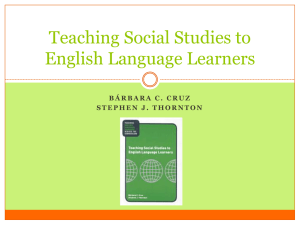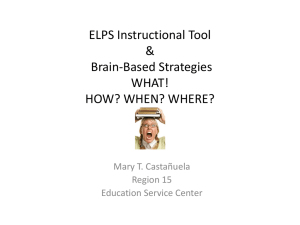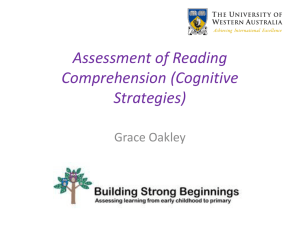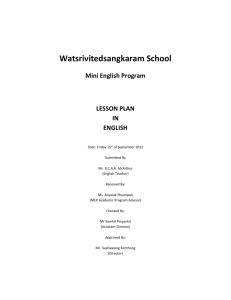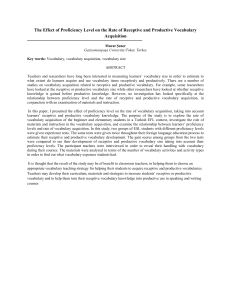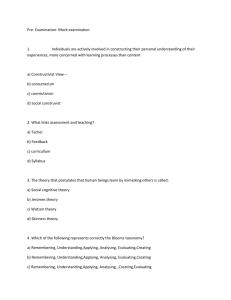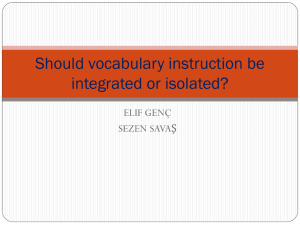Part II - PRAXIS-Study
advertisement
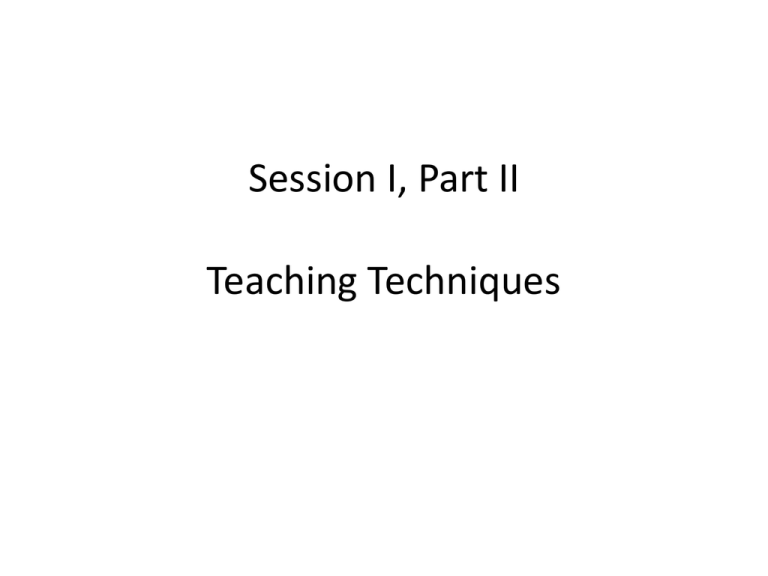
Session I, Part II Teaching Techniques Objective 1: Knows how to organize learning around content and language objectives and align learning with standards • • • • Content and Language objectives Sheltered instruction Content-based instruction Student-centered learning Content and Language Objectives • Learning is organized around both objectives – Content objective: identifies the content (i.e., the facts, concepts of skills of the discipline) to be acquired – Language objective: how language will be used to achieve the content objective; the communication skills necessary to make the content comprehensible • Language objectives are critical for ELLs. In order to teach ELLs effectively, teachers must have an understanding of the language demands of the curriculum and teach accordingly. • Learning objectives should be communicated clearly to students before instruction begins and students should have opportunities to ask questions about the objectives Language Objectives Language Objectives: The Fate of the World Depends Upon Them Sheltered Instruction • All students in the classroom are ELLs (L1 may be the same for all students or there may be many different L1s in the class) – students are at around the same language proficiency level • Content instruction is in English, but the language used is adjusted to match the proficiency level of students in the classroom • Focus is on making content comprehensible and accessible to ELLs • No native language support or development • Goal: fluency in English Content-Based Instruction • CBI is a teaching approach that focuses on learning language through learning about something. • Language comes second to the content. • Although language acquisition is subordinate to the material being presented, the teacher must recognize and be prepared to help students with language skills. • The sheltered classroom is a form of content based instruction. Student Centered Learning • Focuses on the needs of the students – Ability level – Interests – Learning style • Teacher’s role is facilitator – Plan global goals – Assist students in achieving these goals • Students are responsible for their own learning as they assume active roles in the classroom Objective 2: Understands that language instruction should be age appropriate • Games and activities used for younger students will need to be modified for older ones • ELL activities can typically be modified to make them age appropriate for a particular group of students • Students benefit from explicit instruction around how a particular game or activity will help them achieve a language objective (particularly older students and adults) Objective 3: Knows how to collaborate with general education and content area teachers in designing classroom activities appropriate to the language acquisition levels of English-language learners • • • • Language Acquisition Levels Collaboration Peer tutoring Educational technologies Stages of Second Language Acquisition Stage & Approximate Time Frame* Characteristics Preproduction 0-6 months in school • Minimal comprehension • Non-verbal responses Early Production 6 months – 1 year in school • Limited comprehension • One or two word responses Low Intermediate / Speech Emergence 1-3 years in school • Speaking in short phrases, simple sentences • Frequent mistakes in grammar, word order and usage High Intermediate Fluency / Int. Flueny • Developing academic & figurative language 3-5 years in school • Excellent comprehension • Makes fewer grammar mistakes Advanced Fluency 5-7 years in school • Near-native level of speech • Advanced skills in cognitive & academic language *Research shows that lack of L1 skills and/or previous schooling can cause these time frames to lengthen significantly. Collaboration with Teachers • • • • One teach, one observe One teach, one assist Team teaching Parallel teaching – Class split in half – Teachers simultaneously provide the same instruction • Station teaching – Instruction divided into multiple stations in the room – Each teacher provides instruction at one station – Each student participates at each station • Alternative teaching – One teacher takes a small group to the side of the room for instruction Other Teaching Models • Peer tutoring – Peers tutor students who are weak in certain skills – Benefits both students • Tutor reinforces his/her learning • Tutored student gains valuable insights into learning • Educational technologies – Technology offers advantages when tutoring students • Students can practice skills in nonjudgmental environment • Machine does not become tired, lose focus or derail the learning (though the student may!) Objective 4: Knows how to use various methods for promoting students’ acquisition of productive and receptive language skills in both social and academic contexts • Productive language skills – Speaking – Writing • Receptive language skills – Listening – Reading Productive & Receptive Language Skills – Receptive skills are used when listening and reading. Students receive the message and decode the meaning to understand it. – Productive skills are used when speaking and writing. Students use the language they have acquired and produce a message through speech or written text. – In order to fully develop both productive and receptive language skills, students must have many opportunities to produce and receive language in all four of its domains. Pronunciation and Syntax • In order to produce correct pronunciation in English, students must have multiple opportunities to receive (listen to) nativesounding English • In order to produce proper syntax in speaking and writing, students must be exposed to proper English in listening and in reading • It is through the development of their receptive abilities that students will ultimately develop their productive abilities Listening Comprehension Strategies • • • • • • • • Repetition Gestures Facial expressions Realia Illustrations Slowing the pace of instruction Tone of voice Targeted vocabulary Speaking Strategies • • • • • • • One-on-one conferences with students Group activities Brainstorming and problem-solving sessions Group discussions Role-playing Reenactments Presentations (recitations, summarizations, asking questions, speeches, etc.) • Sentence frames and vocabulary walls to draw from in speaking Reading Comprehension Strategies • • • • • • • • • • • • • • • • Modeling Read Alouds Independent Practice Comprehension Activities Activate Prior Knowledge Cognates for Clues Think Alouds Graphic Organizers, Charts, Timelines Front-load vocabulary Variety of texts Explicit instruction One-on-one conferences Duet reading Listen/repeat exercises (echo reading) Choral reading Singing / rhythmic reading Writing Strategies • Model (verbalize their thinking and writing) • Visuals before writing (models, examples, pictures, realia, etc.) • Cooperative learning (collective exploration of topics and writing) • Teach writing process explicitly • Break writing projects into small chunks • Teach grammar in context of writing • Integrate spelling into writing instruction • Provide a list of core words for students to use in writing (focus words for the writing) – word walls, vocabulary banks, etc. Objective 5: Knows a variety of strategies for teaching language skills both discretely and integratively • Phonics instruction – Necessary for the non-native speakers, just as it is helpful for native speakers. Instruction should follow same sequence as for native speakers: • • • • Single consonants at beginning of words Short and long vowels Letter patterns and word families Digraphs (ex: th, ch, ph) and blends (ex: cl, bl, tr, cr) • Pronunciation accuracy (see pronunciation above) • Grammatical accuracy (see syntax above) • Morphological knowledge (will be covered in linguistics session) Objective 6: Knows a variety of strategies for supporting content-based language learning For content-based instruction to be effective, teachers must help ELLs develop the English language skills needed to access the content. Strategies to help ELLs access the content: – Activate schema or prior knowledge – Contextualize key concepts and language of a lesson – Modify and augment content-area texts to meet gaps in students’ prior knowledge, background and/or vocabulary – Demonstrate or model tasks to be completed – Utilize questions to promote critical-thinking – Provide explicit instruction in metacognitive and cognitive strategies – Provide multiple opportunities for students to learn and use academic vocabulary – Provide opportunities for students to use English for communicative purposes – Assess lesson content through various means – Provide comprehensible and meaningful feedback Objective 7: Knows how to design lessons and activities that help students become more effective language learners by developing their cognitive and meta-cognitive strategies • Lessons designed to develop cognitive and metacognitive strategies – Metacognitive Strategies • Centering your learning • Arranging and planning your learning • Evaluating your learning – Cognitive Strategies • Practicing (sound repetition, etc.) • Receiving and sending messages • Analyzing and reasoning • Creating structure for input and output Metacognition • An Intro to Metacognition Objective 8: Knows techniques to help students activate prior knowledge and support appropriate transfer of language and literacy skills from L1 to L2 • Activating prior knowledge – Introducing vocabulary before content – Asking questions about a topic – Asking questions about related topics – Brainstorming about the topic – Using graphic organizers • Schema (Theory of Carrell & Eisterhold) • Positive and negative language transfer SCHEMA • Schema is the framework around information stored in the brain • As new information is received, schemata are activated to store the new information. Schemata refers to prior knowledge and must be tapped into for understanding to be achieved. What is being learned must be connected to what is known in order for learning to take place. • The schema theory (Carrell and Eisterhold) explains how the brain processes knowledge and how its representations facilitate comprehension and learning. VOCAB TERMS • POSITIVE TRANSFER – when L1 and L2 share common rules, positive transfer may occur. A rule that applies in L1 also applies in L2 and helps the learner acquire L2 faster. However, overgeneralizations can cause problems. • NEGATIVE TRANSFER – when L1 and L2 have rules that are in conflict with each other, negative transfer may occur. For example, when a learner applies rules of syntax from Spanish to English, he or she might say, “I have a car blue.” Objective 9: Knows how to design and use activities and assignments to provide students with authentic language use and meaningful interaction in English • Communication must be meaningful and purposeful for students to learn. Otherwise, they may not try. • Communicative language teaching – Meaning through interaction in target language – Materials or texts that reflect real-world language – Rehearse language outside classroom by focusing on language forms, skills, or learning process – Focus on prior knowledge – Plan for links between classroom and real-world language • Communication is necessary – students must interact with the teacher and peers in order to develop their skills. They must develop their skills in all four domains. Objective 10: Is familiar with best practices for teaching English Literacy to both literate and nonliterate English-language learners • Techniques for teaching literate versus illiterate students in their native language • Newcomer Students

